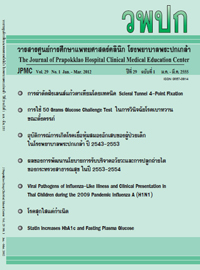The development of the Public Health Ministry’s policy on organ donation and kidney transplantation: fiscal years 2010 – 2011
Main Article Content
Abstract
The study on the development of the Public Health Ministry’s policy on organ donation and kidney transplantation was carried out during January – March 2012 with the main objectives of (1) situation analysis on organ donation and kidney transplanted by the Ministry of Public Health and (2) finding out the outcomes of the development of the Ministry’s policy on organ donation and kidney transplantation and changes occurred. The secondary data and documents from related reporting system were analyzed for this descriptive study. It was found that after the strategies were formulated and the policy on system development for organ donation and kidney transplantation was given to service centers at the regional level i.e. regional / general hospitals all over the country totaling 96, the number of organ donors who were the patients with brain death during the years 2009 through 2011 for the whole country had an outstanding rising trend. There were 80, 87 and 113 organ donors in 2009, 2010 and 2011 respectively. It was shown that the increasing number of patients who were waiting for organ or kidney transplantations could be treated. There were 302, 354 and 402 patients with kidney transplanted in 2009, 2010 and 2011 respectively. It could be seen that there was a tendency of increasing number of patients with organ transplantation at the estimate of 13 – 18 percent from the baseline number each year. Therefore, it was a good opportunity for patients to be well treated especially those who were poor and were in the remote areas. From the implementation of the mentioned strategies and plan, it was found that the policy development and transfer to sectors at regional level for further implementation and the formulation of strategies among all stakeholders resulted in the integrated implementation of plan. The involvement of concerned sectors and organizations was also the key success for the concrete implementation of policy, strategies and work plan. These could help patients with chronic kidney disease gain access to kidney transplantation service with increasing quality and satisfaction. บทคัดย่อ การรักษาผู้ป่วยโดยวิธีการปลูกถ่ายอวัยวะ เป็นวิธีการรักษาที่ช่วยทำ ให้ผู้ป่วยมีคุณภาพชีวิตที่ ดีขึ้นและสามารถดำ เนินชีวิตที่ใกล้เคียงปกติมากที่สุด แต่การบริจาคอวัยวะจากผู้ป่วยที่มีภาวะสมอง ตายพบว่ามีจำ นวนน้อยมากเมื่อเทียบกับผู้ป่วยที่รอรับการปลูกถ่ายอวัยวะ กระทรวงสาธารณสุขได้ ตระหนักถึงความสำ คัญของการรักษาผู้ป่วยโดยวิธีการปลูกถ่ายอวัยวะ จึงได้จัดทำ แผนและพัฒนา นโยบายการรับบริจาคอวัยวะและการปลูกถ่ายไตของกระทรวงสาธารณสุข ในปี 2553-2554 ดำ เนิน การโดยเน้นการ บูรณาการแผนงานกับหน่วยงานองค์กรต่างๆที่เกี่ยวข้อง การศึกษาผลของการพัฒนา นโยบายดังกล่าว เป็นการศึกษาเชิงพรรณนาโดยใช้ข้อมูลทุติยภูมิ และจากเอกสารระบบการรายงาน ที่เกี่ยวข้อง ดำ เนินการศึกษาระหว่างเดือนมกราคม – มีนาคม 2555 โดยมีวัตถุประสงค์เพื่อศึกษา สถานการณ์ การรับบริจาคอวัยวะและการปลูกถ่ายไตของกระทรวงสาธารณสุข และผลของการพัฒนา ที่เกิดขึ้นว่า ก่อให้เกิดการเปลี่ยนแปลงอย่างไร ผลการศึกษาพบว่าภายหลังจากมีการจัดทำ ยุทธศาสตร์และมอบนโยบายการพัฒนาระบบการ รับบริจาคอวัยวะและการปลูกถ่ายไตให้กับหน่วยบริการในส่วนภูมิภาคที่เป็นโรงพยาบาลศูนย์ / โรง พยาบาลทั่วไปทุกจังหวัดทั่วประเทศ 96 แห่ง เมื่อวิเคราะห์เปรียบเทียบจำ นวนผู้บริจาคอวัยวะ จากผู้ ป่วยที่มีภาวะสมองตายระหว่างปี 2552-2554 พบว่าในภาพรวมทั้งประเทศมีแนวโน้มที่เพิ่มขึ้นอย่าง ชัดเจน โดยในปี 2552 มีจำ นวนผู้บริจาคอวัยวะ 80 ราย ปี 2553 จำ นวน 87 ราย และปี 2554 จำ นวน 113 ราย ทำ ให้ผู้ป่วยที่รอรับการปลูกถ่ายอวัยวะหรือการปลูกถ่ายไตได้รับการปลูกถ่ายอวัยวะเพิ่ม มากขึ้น โดยปี 2552 ผู้ป่วยได้รับการปลูกถ่ายไต จำ นวน 302 ราย ปี 2553 จำ นวน 354 ราย และปี 2554 จำ นวน 402 ราย จะเห็นได้ว่าผู้ป่วยมีแนวโน้มได้รับการปลูกถ่ายอวัยวะมากขึ้นตามลำ ดับ คิด ประมาณการร้อยละ 13-18 จากฐานเดิมในแต่ละปี จึงนับเป็นการสร้างโอกาสให้ผู้ป่วยได้รับการรักษา ที่ดี โดยเฉพาะผู้ป่วยที่อยู่ในเขตภูมิภาคและผู้ป่วยยากไร้ จากผลการดำ เนินการดังกล่าว จะพบว่าการดำ เนินการโดยมีการพัฒนานโยบายและมอบนโยบาย ไปสู่การปฏิบัติของหน่วยงานในส่วนภูมิภาค และการจัดทำ แผนยุทธศาสตร์ร่วมกับผู้มีส่วนได้ส่วนเสีย ที่สำ คัญทำ ให้เกิดการบูรณาการในการดำ เนินการและการมีส่วนร่วมซึ่งถือเป็นหัวใจของความสำ เร็จ (key success) ที่จะช่วยในการขับเคลื่อนนโยบาย ยุทธศาสตร์ และแผนงานไปสู่การปฏิบัติอย่างเป็นรูป ธรรม เป็นผลให้ผู้ป่วยโรคไตเรื้อรังได้เข้าถึงบริการปลูกถ่ายไตที่ดี มีคุณภาพและเพิ่มขึ้นอย่างพึงพอใจ
Article Details
Issue
Section
Original article
